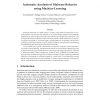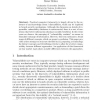87 search results - page 6 / 18 » On the Concept of Software Obfuscation in Computer Security |
JCS
2011
12 years 10 months ago
2011
Malicious software—so called malware—poses a major threat to the security of computer systems. The amount and diversity of its variants render classic security defenses ineffe...
NSPW
2003
ACM
14 years 26 days ago
2003
ACM
The ability to analyze and modify binaries is often very useful from a security viewpoint. Security operations one would like to perform on binaries include the ability to extract...
ISCA
2010
IEEE
14 years 21 days ago
2010
IEEE
Phase change memory (PCM) is an emerging memory technology for future computing systems. Compared to other non-volatile memory alternatives, PCM is more matured to production, and...
JUCS
2010
13 years 2 months ago
2010
: One of the most important use-cases of Trusted Computing is Remote Attestation. It allows platforms to get a trustworthy proof of the loaded software and current configuration of...
ETRICS
2006
13 years 11 months ago
2006
Abstract. Practical computer (in)security is largely driven by the existence of and knowledge about vulnerabilities, which can be exploited to breach security mechanisms. Although ...


